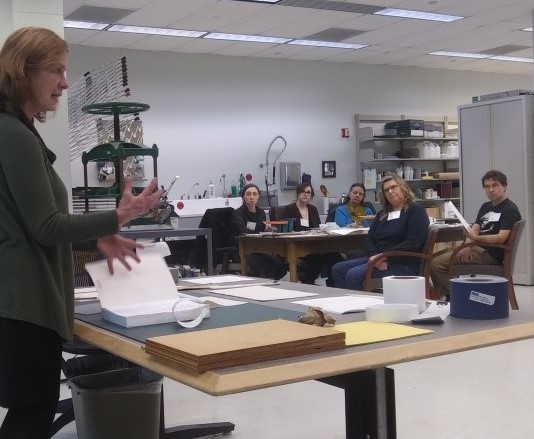On March 3, 2020, the Alice Hastings Murphy Preservation Department in the University Libraries hosted a two-day workshop, Oversized Book Repair for General and Reference Collections. This was the most recent offering in the Preservation Department’s annual outreach programming for local, regional, and statewide organizations.
Twelve participants from institutions in Albany, Saratoga, New Paltz, and Buffalo, attended the program. The workshop was taught by Karen Kiorpes, Head of the Preservation Department, and Ann Kearney, Collections Conservator.

The first day began with a round-robin “meet and greet.” Instructors and attendees introduced themselves, talked about the libraries they represent, the extent and types of collections they maintain, and voiced their particular concerns regarding oversized volumes. Each person brought with them several items that showed damage that is typical in their collections, and each talked about the challenges presented by these examples. Some were tall, heavy art books; others were short, thick reference volumes. Kearney and Kiorpes presented possible basic conservation solutions, and discussed which of these the group would be addressing that afternoon and the next day. Following a brief lunch break, Kearney demonstrated a few simple procedures that would familiarize attendees with conservation tools and materials. The last part of the day was devoted to learning and practicing a repair procedure appropriate for general collections items.
The second day began with a review of the previous day’s work, followed by an introduction a ‘large-scale’ version of the same exercise; once again time was built in for practice. After lunch, Kiorpes reviewed commercially-available enclosures and commercial binding options while students finished repairing their larger books. Participants completed three to five books each during the course of the second afternoon. The workshop ended with a review and assessment of the completed work. During this concluding round-robin conversation, all parties discussed what they had learned, the successes they had experienced, and the knowledge and skills they had acquired to maintain and improve the condition of their collections.
The members of the Preservation Department appreciate having the opportunity to share their resources and their space with local and regional collections’ communities. They also value having the opportunity to interact with community members, to become aware of their preservation needs, and to expand the resources available to our district and region. In addition, they prize the experience of meeting others facing the same challenges, and being able to have conversations about these challenges and about possible solutions.